Norops (clade)
| Norops | |
|---|---|
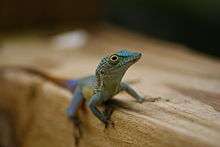 | |
| Anolis grahami, also called Norops grahami, in Jamaica | |
| Scientific classification | |
| Kingdom: | Animalia |
| Phylum: | Chordata |
| Class: | Reptilia |
| Order: | Squamata |
| Suborder: | Lacertilia |
| Family: | Polychrotidae |
| Genus: | Anolis |
| (unranked): | Norops |
| Species | |
|
c.169, see text | |
Norops is a clade of 169 species of polychrotid lizards within the genus Anolis. Evidence for the clade's recognition stems from the fact that all of its designated species possess sufficient differences in morphology, especially in the structure and design of tail vertebrae, to suggest a deep divergence from the rest of Anolis.[1] The exact position of Norops and other distinct species groups within Anolis, either as clades or as genera, has been a subject of ongoing debate among anole scientists, however the description of Norops and other clades as genera is rapidly losing support within the scientific community;[2] however, it is unclear as to whether this debate will ever be completely resolved.

Taxonomic Status
In Richard E. Etheridge's original 1959 publication he recognized Anolis as an extremely diverse genus, and also recognized ten other genera including Norops, however he ultimately concluded that only four of these genera were morphologically unusual enough to warrant separation from Anolis.[3][4] Thus Etheridge concluded that the rest of the genera were simply deeply divergent groups of Anolis that were still firmly nestled within the genus. However the most recognized part of Etheridge's publication was his proposal to split Anolis into alpha and beta series based on morphological differences in caudal vertebrae.[4] In a 1986 publication Craig Guyer and Jay Savage applied the genus name Norops to Etheridge's beta anoles and also divided the rest of Anolis into four other genera. This proposal has been mostly rejected by the anole community as Norops was one of only a few of these genera proven to be monophyletic. During the 1990s and early 2000s some biologists working in Central America also began assigning certain species in Etheridge’s beta section of Anolis into Norops. Though Norops is usually proposed as a separate genus from Anolis the name Norops was originally treated by Kristen. E. Nicholson (2002) as a name for a clade of lizards nestled within the genus Anolis, but distinct in terms of certain aspects of skeletal morphology which differentiate them from all other anoles.[5] Ironically Nicholson is also the first author of a 2012 publication proposing the split of Anolis into several genera.[6] The classification of Norops as a clade is often preferred by the scientific community as classification of Norops as a genus separate from Anolis would necessitate the designation of several other species formerly placed in Anolis into newly created genera (as proposed by Guyer and Savage (1986) and Nicholson (2012)), several of which have proven to be paraphyletic; however the separation of Anolis into several distinct but interrelated clades would make anole classification easier without necessitating the creation of several new genera. This was also part of the reason why Etheridge left his beta anoles within the genus Anolis even though he recognized that there were some differences between the two groups. There is still much debate regarding the placement of Norops and other distinct groups within Anolis. In December 2012 the online website The Reptile Database revised their classification of Anolis and followed Nicholson in splitting the genus into eight new genera; however all the new genera were grouped back into Anolis in April 2013. Norops continues to be recognized as a genus by workers in Central America [2] However, it is universally rejected by West Indian workers. These differences may be due to the fact the mainland fauna is dominated by only two deeply divergent clades (Norops and Dactyloa in Guyer and Savage's terminology), whereas the West Indian radiation is much more taxonomically diverse, and relationships less certain.
Morphological characteristics
Whether Norops is classified as a clade or a genus, most taxonomists have agreed on what morphological characteristics warrant the placement of a species inside the group. Etheridge classified his beta anoles as species that shared the certain aspects of vertebral morphology; Nicholson et al. went further by defining Norops as species that shared the following specific aspects of skeletal morphology:[6]
- structure of caudal vertebrae and mechanism of autotomy
- location of pineal foramen
- absence of pterygoid teeth
- usual absence of splenial
- lower jaw morphology
- number of lumbar vertebrae
Nicholson also used these criteria when proposing species to be placed in the genus Norops. There is remarkable morphological variation within this clade, even relative to other clades in Anolis; however most Norops species share a set of similar characteristics that are readily observable even to the untrained eye; they are usually small to mid-size anoles, though a few species such as A.garmani can grow much larger.[6] They typically have robust bodies and stout, blunt heads; they exist in a variety of ecomorphs.[6] Females rarely possess a dewlap.
List of Species.
The following is a list of species that have been proposed as belonging in the clade Norops.[7]
- Anolis ahli (BARBOUR, 1925)
- Anolis allogus (BARBOUR & RAMSDEN, 1919)
- Anolis altae (DUNN, 1930)
- Anolis alvarezdeltoroi (NIETO MONTES DE OCA, 1996)
- Anolis amplisquamosus (MCCRANIE, WILSON & WILLIAMS, 1993)
- Anolis anchicayae (POE, VELASCO, MIYATA & WILLIAMS, 2009)
- Anolis anisolepis (SMITH, BURLEY & FRITTS, 1968)
- Anolis annectens (WILLIAMS, 1974)
- Anolis anoriensis (VELASCO, GUTIÉRREZ-CÁRDENAS & QUINTERO-ANGEL, 2010)
- Anolis antonii (BOULENGER, 1908)
- Anolis apletophallus (KÖHLER & SUNYER, 2008)
- Anolis aquaticus (TAYLOR, 1956)
- Anolis auratus (DAUDIN, 1802)
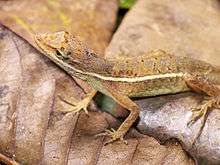
- Anolis barkeri (SCHMIDT, 1939)
- Anolis beckeri (BOULENGER, 1881)
- Anolis benedikti (LOTZKAT, BIENENTREU, HERTZ & KÖHLER, 2011)
- Anolis bicaorum (KÖHLER, 1996)
- Anolis binotatus PETERS, 1863
- Anolis biporcatus (WIEGMANN, 1834)
- Anolis birama (GARRIDO, 1990)
- Anolis bitectus (COPE, 1864)
- Anolis bombiceps (COPE, 1876)
- Anolis brasiliensis (VANZOLINI & WILLIAMS, 1970)
- Anolis breedlovei (SMITH & PAULSON, 1968)
- Anolis bremeri (BARBOUR, 1914)
- Anolis campbelli (KÖHLER & SMITH, 2008)
- Anolis capito (PETERS, 1863)
- Anolis carpenteri (ECHELLE, ECHELLE & FITCH, 1971)
- Anolis charlesmyersi (KÖHLER, 2010)
- Anolis chrysolepis (DUMÉRIL & BIBRON, 1837)
- Anolis cobanensis (STUART, 1942)
- Anolis compressicauda (SMITH & KERSTER, 1955)
- Anolis concolor (COPE, 1862)
- Anolis confusus (ESTRADA & GARRIDO, 1991)
- Anolis conspersus (GARMAN, 1887)

- Anolis crassulus (COPE, 1864)
- Anolis cristifer(SMITH, 1968)
- Anolis cryptolimifrons (KÖHLER & SUNYER, 2008)
- Anolis cupreus (HALLOWELL, 1860)
- Anolis cuprinus (SMITH, 1964)
- Anolis cusuco (MCCRANIE, KÖHLER & WILSON, 2000)
- Anolis cymbops (COPE, 1864)
- Anolis damulus COPE, 1864
- Anolis datzorum (KÖHLER, PONCE, SUNYER & BATISTA, 2007)
- Anolis delafuentei (GARRIDO, 1982)
- Anolis dollfusianus (BOCOURT, 1873)
- Anolis duellmani (FITCH & HENDERSON, 1973)
- Anolis dunni (SMITH, 1936)
- Anolis eewi (ROZE, 1958)
- Anolis forbesorum (SMITH & VAN GELDER, 1955)
- Anolis fortunensis (AROSEMENA & IBANEZ, 1993)
- Anolis fraseri (GÜNTHER, 1859)
- Anolis fungosus (MYERS, 1971)
- Anolis fuscoauratus (D’ORBIGNY, 1837)
- Anolis gadovii (BOULENGER, 1905)
- Anolis garmani (STEJNEGER, 1899)
- Anolis gibbiceps (COPE, 1864)
- Anolis gracilipes (BOULENGER, 1898)
- Anolis grahami (GRAY, 1845)
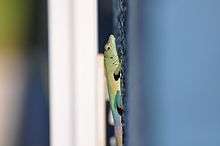
- Anolis granuliceps (BOULENGER, 1898)
- Anolis gruuo (KÖHLER, PONCE, SUNYER & BATISTA, 2007)
- Anolis guafe (ESTRADA & GARRIDO, 1991)
- Anolis guazuma GARRIDO, 1984
- Anolis haguei (STUART, 1942)
- Anolis hobartsmithi (NIETO-MONTES DE OCA, 2001)
- Anolis homolechis (COPE, 1864)
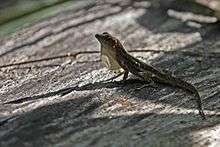
- Anolis humilis (PETERS, 1863)
- Anolis ibague (WILLIAMS, 1975)
- Anolis imias (RUIBAL & WILLIAMS, 1961)
- Anolis impetigosus COPE, 1864
- Anolis intermedius (PETERS, 1863)
- Anolis isthmicus (FITCH, 1979)
- Anolis johnmeyeri (WILSON & MCCRANIE, 1982)
- Anolis jubar (SCHWARTZ, 1968)
- Anolis kemptoni (DUNN, 1940)
- Anolis kreutzi (MCCRANIE, KÖHLER & WILSON, 2000)
- Anolis laeviventris (WIEGMANN, 1834)
- Anolis lemniscatus (BOULENGER, 1898)
- Anolis lemurinus (COPE, 1861)
- Anolis limifrons (COPE, 1862)
- Anolis lineatopus (GRAY, 1840)
- Anolis lineatus (DAUDIN, 1802)
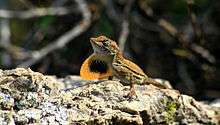
- Anolis liogaster (BOULENGER, 1905)
- Anolis lionotus (COPE, 1861)
- Anolis loveridgei (SCHMIDT, 1936)
- Anolis luteosignifer (GARMAN, 1888)
- Anolis lynchi (MIYATA, 1985)
- Anolis lyra (POE, VELASCO, MIYATA & WILLIAMS, 2009)
- Anolis macrinii (SMITH, 1968)
- Anolis macrolepis (BOULENGER, 1911)
- Anolis macrophallus (WERNER, 1917)
- Anolis maculiventris (BOULENGER, 1898)
- Anolis magnaphallus (POE & IBÁNEZ, 2007)
- Anolis mariarum (BARBOUR, 1932)
- Anolis matudai (SMITH, 1956)
- Anolis medemi (AYALA & WILLIAMS, 1988)
- Anolis megapholidotus (SMITH, 1933)
- Anolis meridionalis (BOETTGER, 1885)
- Anolis mestrei (BARBOUR & RAMSDEN, 1916)
- Anolis microlepidotus (DAVIS, 1954)
- Anolis microlepis ÁLVAREZ DEL TORO & SMITH, 1956
- Anolis milleri (SMITH, 1950)
- Anolis monteverde (KÖHLER, 2009)
- Anolis morazani (TOWNSEND & WILSON, 2009)
- Anolis muralla (KÖHLER, MCCRANIE & WILSON, 1999)
- Anolis naufragus (CAMPBELL, HILLIS & LAMAR, 1989)
- Anolis nebuloides (BOCOURT, 1873)
- Anolis nebulosus (WIEGMANN, 1834)
- Anolis nelsoni (BARBOUR, 1914)
- Anolis notopholis (BOULENGER, 1896)
- Anolis ocelloscapularis (KÖHLER, MCCRANIE & WILSON, 2001)
- Anolis oligaspis COPE, 1894
- Anolis omiltemanus (DAVIS, 1954)
- Anolis onca (O’SHAUGHNESSY, 1875)
- Anolis opalinus (GOSSE, 1850)
- Anolis ophiolepis (COPE, 1861)
- Anolis ordinatus (COPE, 1864)
- Anolis ortonii (COPE, 1868)
- Anolis osa (KÖHLER, DEHLING & KÖHLER, 2010)
- Anolis otongae (AYALA-VARELA & VELASCO, 2010)
- Anolis oxylophus (COPE, 1876)
- Anolis pachypus (COPE, 1876)
- Anolis parvicirculatus (ALVAREZ DEL TORO & SMITH, 1956)
- Anolis pentaprion (COPE, 1863)
- Anolis petersii (BOCOURT, 1873)
- Anolis pijolense (MCCRANIE, WILSON & WILLIAMS, 1993)
- Anolis pinchoti (COCHRAN, 1931)
- Anolis planiceps (TROSCHEL, 1848)
- Anolis poecilopus (COPE, 1862)
- Anolis polylepis (PETERS, 1874)
- Anolis polyrhachis (SMITH, 1968)
- Anolis pseudokemptoni (KÖHLER, PONCE, SUNYER & BATISTA, 2007)
- Anolis pseudopachypus (KÖHLER, PONCE, SUNYER & BATISTA, 2007)
- Anolis purpurgularis (MCCRANIE, CRUZ & HOLM, 1993)
- Anolis pygmaeus (ALVAREZ DEL TORO & SMITH, 1956)
- Anolis quadriocellifer (BARBOUR & RAMSDEN, 1919)
- Anolis quaggulus (COPE, 1885)
- Anolis quercorum (FITCH, 1979)
- Anolis radulinus COPE, 1862
- Anolis reconditus (UNDERWOOD & WILLIAMS, 1959)
- Anolis rhombifer BOULENGER, 1894
- Anolis rivalis (WILLIAMS, 1984)
- Anolis roatanensis (KÖHLER & MCCRANIE, 2001)
- Anolis rodriguezi (BOCOURT, 1873)
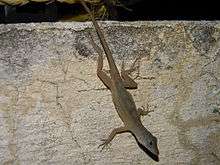
- Anolis rubribarbaris (KÖHLER, MCCRANIE & WILSON, 1999)
- Anolis rubribarbus (BARBOUR & RAMSDEN, 1919)
- Anolis sagrei (DUMÉRIL & BIBRON, 1837)
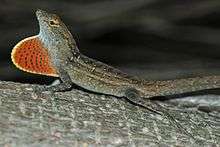
- Anolis salvini (BOULENGER, 1885)
- Anolis scapularis (BOULENGER, 1908)
- Anolis schiedei (WIEGMANN, 1834)
- Anolis schmidti (SMITH, 1939)
- Anolis scypheus (COPE, 1864)
- Anolis sericeus (HALLOWELL, 1856)
- Anolis serranoi (KÖHLER, 1999)
- Anolis simmonsi HOLMAN, 1964
- Anolis sminthus (DUNN & EMLEN, 1932)
- Anolis subocularis (DAVIS, 1954)
- Anolis sulcifrons (COPE, 1899)
- Anolis tandai (AVILA-PIRES, 1995)
- Anolis taylori (SMITH & SPIELER, 1945)
- Anolis tenorioensis (KÖHLER, 2011)
- Anolis tolimensis (WERNER, 1916)
- Anolis townsendi (STEJNEGER, 1900)
- Anolis trachyderma (COPE, 1876)
- Anolis tropidogaster (HALLOWELL, 1856)
- Anolis tropidolepis (BOULENGER, 1885)
- Anolis tropidonotus (PETERS, 1863)
- Anolis uniformis (COPE, 1885)
- Anolis unilobatus (KÖHLER & VESELY, 2010)
- Anolis utilensis (KÖHLER, 1996)
- Anolis utowanae (BARBOUR, 1932)
- Anolis valencienni (DUMÉRIL & BIBRON, 1837)
- Anolis vicarius (WILLIAMS, 1986)
- Anolis villai (FITCH & HENDERSON, 1976)
- Anolis vittigerus COPE, 1862

- Anolis wampuensis (MCCRANIE & KÖHLER, 2001)
- Anolis wellbornae (AHL, 1940)
- Anolis wermuthi (KÖHLER & OBERMEIER, 1998)
- Anolis williamsii (BOCOURT, 1870)
- Anolis woodi (DUNN, 1940)
- Anolis yoroensis (MCCRANIE, NICHOLSON & KÖHLER, 2001)
- Anolis zeus (KÖHLER & MCCRANIE, 2001)
Phenotypical Comparison
Below is a table showing a phenotypical comparison of selected species in the proposed clade Norops.
| species name | image |
|---|---|
| Cuban brown anole (Anolis sagrei) |
.jpg) |
| Neotropical green anole (Anolis biporcatus) |
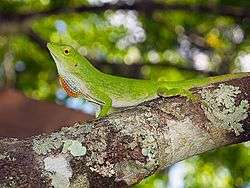 |
| Graham's anole (Anolis grahami) |
 |
| Golfo-Dulce anole (Anolis polylepis) |
|
| Garland anole (Anolis vittigerus) |
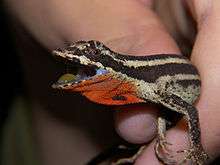 |
| Jamaican giant anole (Anolis garmani) |
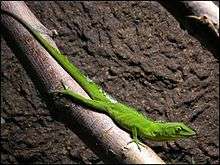 |
| Humble anole (Anolis humilis) |
 |
| Cayman blue throated anole (Anolis conspersus) |
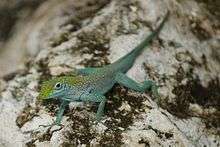 |
| Sagua de Tánamo anole (Anolis rubribarbus) |
 |
| Silky anole (Anolis sericeus) |
 |
| Stream anole (Anolis poecilopus) |
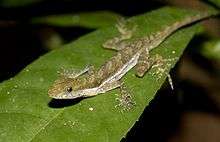 |
| Blemished anole (Anolis mariarum) |
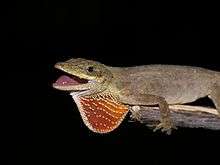 |
| Spanish flag anole (Anolis allogus) | 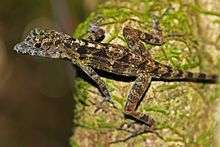 |
Distribution and colonization

Norops is an extremely successful clade of anoles; it is one of two anole clades found on the mainland of South and Central America, the other being Dactyloa. The clade is especially prevalent in Central America which has been suggested as the reason why Central American scientists usually recognize it as a genus. They are also found on West Indian islands, including all four Greater Antillean islands and several islands in the Lesser Antilles. They are exceptionally good colonizers and several species have established thriving populations outside of their native territories, often outcompeting indigenous lizards, including other anoles. A few such examples are the Cuban brown anole, which is native to the Greater Antillean island of Cuba as well as the Bahamas, but has colonized numerous other Caribbean islands as well as certain areas of the continental United States, and has now spread as far east as Taiwan.[8] In parts of Florida the introduced brown anoles are having a negative effect on the native green anole population.[9] Green anoles were originally generally found anywhere from the hedges to the treetops, however, since the introduction of Brown anoles in the 1970s green anoles have been relegated almost exclusively to the treetops, while brown anoles have entirely colonized ground level areas.[9]
Another example is the Jamaican anole, also called Graham's anole (Anolis grahami) which was originally endemic to Jamaica but was deliberately introduced to Bermuda in 1905 to control the fruit fly population. However, the anole quickly outcompeted Bermuda's only native lizard, the Bermudan rock skink, and became the most widespread reptile species on the island.[10] It has further endangered the already vulnerable rock skink and inhibited the colonization of Bermuda by other anole species.[10] It is also believed that mainland species of Norops are the descendants of West Indian colonizers.
Origin
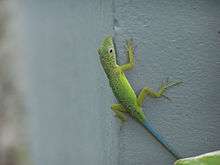
Until recently it was believed that colonization from the mainland to the West Indies was responsible for the current distribution of the Norops clade across the Caribbean. This hypothesis was chosen because successful colonization from small islands to the mainland rarely occurs while the opposite is often true; however a paper published by Nicholson and colleagues concluded that the mainland Norops species were actually the result of speciation events occurring within populations of West Indian species that had made it to the mainland. This conclusion was drawn from the fact that the Norops clade is nested within a branch of Anolis that is primarily West Indian; also mainland Norops species form a monophyletic clade that is nested within a group whose other members are West Indian.[11] The paper also asserted that a West Indian origin for Norops is entirely feasible as such island-to-mainland colonization events have occurred multiple times within Anolis.[11] Like most aspects of anole research, the scientific community's position on the origin of Norops is subject to debate.
References
- ↑ Kristen E.Nicholson (2002). "Phylogenetic analysis and a test of the current infrageneric classification of Norops (beta Anolis)". Herpetological Monographs. The Herpetologists' League. 16 (1): 93–120. doi:10.1655/0733-1347(2002)016[0093:PAAATO]2.0.CO;2.
- 1 2 Jonathan Lossos (January 7, 2011). "Norops last stand". Anole Annals.org. WordPress. Retrieved 19 May 2013.
- ↑ Etheridge, R. (“1959”, 1960) The Relationships of the Anoles (Reptilia: Sauria: Iguanidae): An Interpretation Based on Skeletal Morphology. PhD. Dissertation, University of Michigan, Ann Arbor, 236 pp.
- 1 2 Rich Glor (October 1, 2012). "Historical Perspective On Anole Genera". Anole Annals.org. WordPress. Retrieved 19 May 2013.
- ↑ Kevin de Queiroz (October 4, 2012). "The PhyloCode and the Names of Anole Clades". Anole Annals. WordPress. Retrieved 31 May 2013.
- 1 2 3 4 Nicholson, Kristen A.; Brian I.Crother; Craig Guyer; Jay M.Savage (2012). "It is time for a new classification of anoles (Squamata:Dactyloidae)" (PDF). Zootaxa. Magnolia Press: 1–108.
- ↑ "Norops Search results". The Reptile Database. Retrieved 27 May 2013.
- ↑ "Anolis sagrei (brown anole) distribution". Smithsonian Marine Station. June 12, 2007. Retrieved 19 May 2013.
- 1 2 "Nonnatives - Brown Anole". Florida Fish and Wildlife Conservation Commission. Retrieved 19 May 2013.
- 1 2 Cecilia Hackett (1986). "Lizards Of Bermuda" (PDF). Bermuda Zoological Society. p. 5. Retrieved 20 May 2013.
- 1 2 Nicholson, Kirsten E.; Glor, Richard E.; Kolbe, Jason J.; Larson, Allan; Blair Hedges, S.; Losos, Jonathan B. (2005). "Mainland colonization by island lizards" (PDF). Journal of Biogeography. 32 (6): 929–938. doi:10.1111/j.1365-2699.2004.01222.x. Cite uses deprecated parameter
|coauthors=(help)